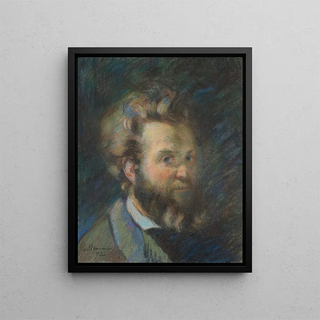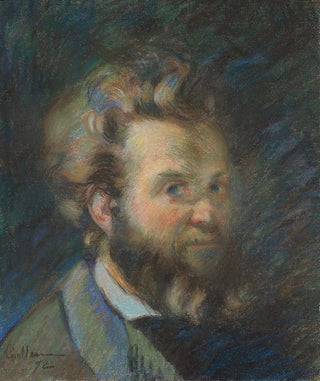Art print Self-portrait - Armand Guillaumin | Art print


View from behind

Frame (optional)
Autoportrait Art print - Armand Guillaumin – Captivating introduction
The Autoportrait by Armand Guillaumin is an iconic work that immerses the viewer in the vibrant universe of the late 19th century. This painting, both intimate and daring, reveals not only the artist's face but also his soul, emotions, and reflections on his own journey. Looking into the mirror, Guillaumin does not merely depict his physical appearance; he captures the very essence of his being, inviting the viewer to an exploration of oneself and art. Light plays a leading role in this piece, accentuating facial features and creating an atmosphere that is both warm and melancholic. The art print of this autoportrait allows for rediscovering the depth of this masterpiece, a true testament to the artist's quest for identity.
Style and uniqueness of the work
The Autoportrait by Armand Guillaumin stands out for its Impressionist style, characterized by bold brushstrokes and a palette of vibrant colors. The artist uses warm tones that blend harmoniously, creating a sense of movement and life. This chromatic choice, combined with a quick and spontaneous painting technique, gives the work an almost tactile dimension. Each brushstroke seems charged with energy, as if the artist aimed to capture a fleeting moment. Light, omnipresent, illuminates Guillaumin's face, highlighting his features and expressions. This play of light and shadow contributes to giving emotional depth to the piece, allowing the viewer to feel the complexity of the feelings that inhabit the artist. Thus, the autoportrait is not only a simple representation but a true exploration of identity and human emotion.
The artist and his influence
Armand Guillaumin, an emblematic figure of Impressionism, knew how to mark his era with his innovative approach to painting. Born in 1841, he initially worked as a draftsman before fully dedicating himself to art. His journey is marked by encounters with masters such as Claude Monet and Camille Pissarro, who influenced his style and artistic development.

Matte finish

View from behind

Frame (optional)
Autoportrait Art print - Armand Guillaumin – Captivating introduction
The Autoportrait by Armand Guillaumin is an iconic work that immerses the viewer in the vibrant universe of the late 19th century. This painting, both intimate and daring, reveals not only the artist's face but also his soul, emotions, and reflections on his own journey. Looking into the mirror, Guillaumin does not merely depict his physical appearance; he captures the very essence of his being, inviting the viewer to an exploration of oneself and art. Light plays a leading role in this piece, accentuating facial features and creating an atmosphere that is both warm and melancholic. The art print of this autoportrait allows for rediscovering the depth of this masterpiece, a true testament to the artist's quest for identity.
Style and uniqueness of the work
The Autoportrait by Armand Guillaumin stands out for its Impressionist style, characterized by bold brushstrokes and a palette of vibrant colors. The artist uses warm tones that blend harmoniously, creating a sense of movement and life. This chromatic choice, combined with a quick and spontaneous painting technique, gives the work an almost tactile dimension. Each brushstroke seems charged with energy, as if the artist aimed to capture a fleeting moment. Light, omnipresent, illuminates Guillaumin's face, highlighting his features and expressions. This play of light and shadow contributes to giving emotional depth to the piece, allowing the viewer to feel the complexity of the feelings that inhabit the artist. Thus, the autoportrait is not only a simple representation but a true exploration of identity and human emotion.
The artist and his influence
Armand Guillaumin, an emblematic figure of Impressionism, knew how to mark his era with his innovative approach to painting. Born in 1841, he initially worked as a draftsman before fully dedicating himself to art. His journey is marked by encounters with masters such as Claude Monet and Camille Pissarro, who influenced his style and artistic development.
12,34 €






